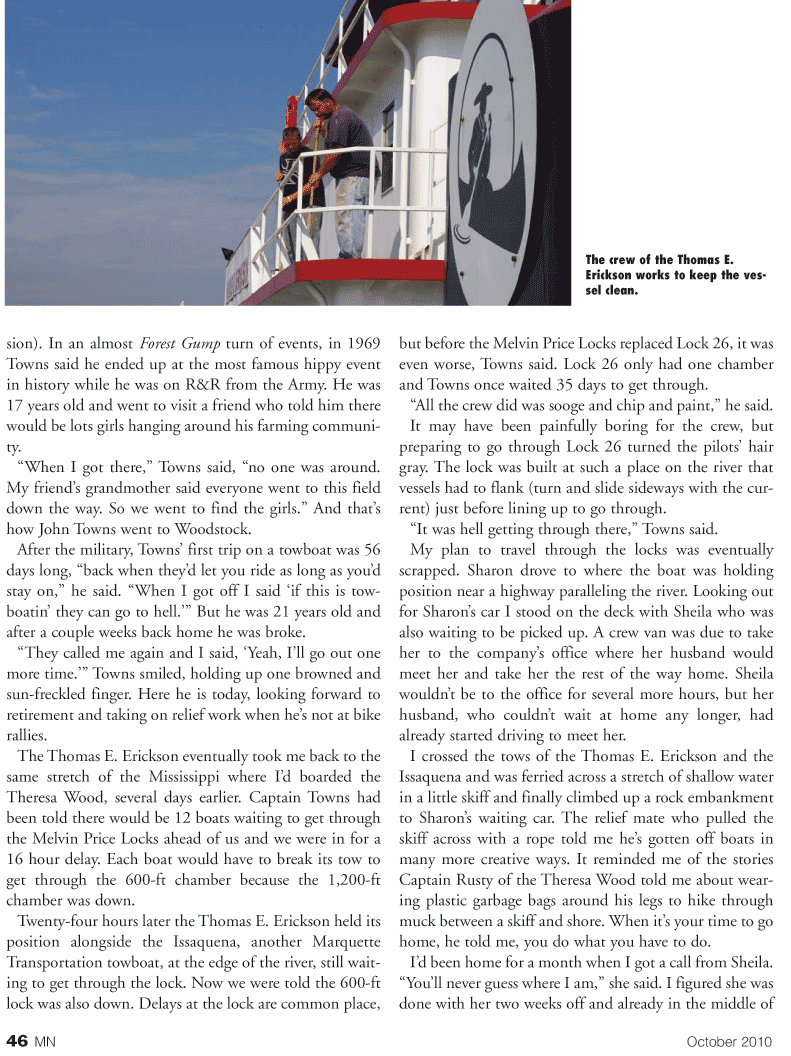
Page 46: of Marine News Magazine (October 2010)
Annual World Yearbook
Read this page in Pdf, Flash or Html5 edition of October 2010 Marine News Magazine
46 MN October 2010 sion). In an almost Forest Gump turn of events, in 1969
Towns said he ended up at the most famous hippy event in history while he was on R&R from the Army. He was 17 years old and went to visit a friend who told him there would be lots girls hanging around his farming communi- ty. “When I got there,” Towns said, “no one was around.
My friend’s grandmother said everyone went to this field down the way. So we went to find the girls.” And that’s how John Towns went to Woodstock.
After the military, Towns’ first trip on a towboat was 56 days long, “back when they’d let you ride as long as you’d stay on,” he said. “When I got off I said ‘if this is tow- boatin’ they can go to hell.’” But he was 21 years old and after a couple weeks back home he was broke. “They called me again and I said, ‘Yeah, I’ll go out one more time.’” Towns smiled, holding up one browned and sun-freckled finger. Here he is today, looking forward to retirement and taking on relief work when he’s not at bike rallies.
The Thomas E. Erickson eventually took me back to the same stretch of the Mississippi where I’d boarded the
Theresa Wood, several days earlier. Captain Towns had been told there would be 12 boats waiting to get through the Melvin Price Locks ahead of us and we were in for a 16 hour delay. Each boat would have to break its tow to get through the 600-ft chamber because the 1,200-ft chamber was down.
Twenty-four hours later the Thomas E. Erickson held its position alongside the Issaquena, another Marquette
Transportation towboat, at the edge of the river, still wait- ing to get through the lock. Now we were told the 600-ft lock was also down. Delays at the lock are common place, but before the Melvin Price Locks replaced Lock 26, it was even worse, Towns said. Lock 26 only had one chamber and Towns once waited 35 days to get through. “All the crew did was sooge and chip and paint,” he said.
It may have been painfully boring for the crew, but preparing to go through Lock 26 turned the pilots’ hair gray. The lock was built at such a place on the river that vessels had to flank (turn and slide sideways with the cur- rent) just before lining up to go through. “It was hell getting through there,” Towns said.
My plan to travel through the locks was eventually scrapped. Sharon drove to where the boat was holding position near a highway paralleling the river. Looking out for Sharon’s car I stood on the deck with Sheila who was also waiting to be picked up. A crew van was due to take her to the company’s office where her husband would meet her and take her the rest of the way home. Sheila wouldn’t be to the office for several more hours, but her husband, who couldn’t wait at home any longer, had already started driving to meet her.
I crossed the tows of the Thomas E. Erickson and the
Issaquena and was ferried across a stretch of shallow water in a little skiff and finally climbed up a rock embankment to Sharon’s waiting car. The relief mate who pulled the skiff across with a rope told me he’s gotten off boats in many more creative ways. It reminded me of the stories
Captain Rusty of the Theresa Wood told me about wear- ing plastic garbage bags around his legs to hike through muck between a skiff and shore. When it’s your time to go home, he told me, you do what you have to do.
I’d been home for a month when I got a call from Sheila. “You’ll never guess where I am,” she said. I figured she was done with her two weeks off and already in the middle of
The crew of the Thomas E.
Erickson works to keep the ves- sel clean.

 45
45

 47
47
